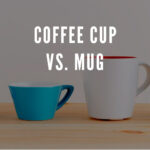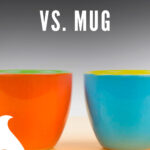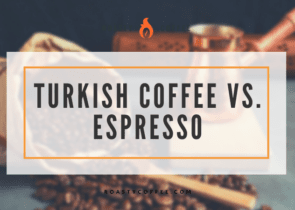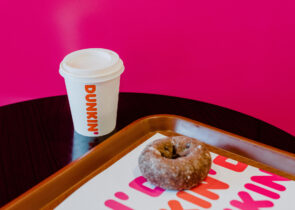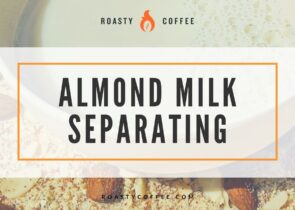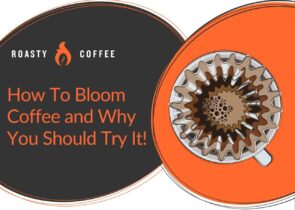There are two types of people. Cup people and mug people. You’re probably asking, “Is there a difference?” You may not have thought about it before. Honestly, when we drink from a coffee mug or a coffee cup, we are more concerned with the daily coffee content than the container.
While they share a sacred purpose as the vessel of life-giving bean juice, there are basic structural differences between a mug and a cup. They are shaped differently, they are used differently, and they typically contain very different types of coffee beverages.
Let’s explore the differences between coffee cups and mugs.
The Shape of Brew
The most noticeable difference between a coffee cup and a coffee mug is in the shape of each. A coffee cup is typically smaller and more fragile, while a coffee mug is sturdy and portable. The shapes of coffee mugs and cups also provide different advantages.
Coffee Cups: Dainty and Delicate

Coffee cups are more delicate and fragile than coffee mugs. Because of this, they are only used if you plan on staying in one place while you enjoy your brew and daily coffee talk with your friends. You won’t see someone with a cup of coffee on a train or walking down a city street. I can already hear porcelain smashing.
Coffee cups are typically short and wide. The diameter of the brim is greater than the diameter of the base. Coffee cups narrow from top to bottom. Imagine the shape of an upside-down bell. The brim of a coffee cup is also wider than the height.
Beverages served in coffee cups are more concentrated and come in smaller amounts. Hence a smaller cup. More coffee is distributed across the surface because of the cup’s small size and wider brim. Therefore, beverages served in coffee cups tend to cool down more quickly.
We typically pair a cup with a saucer. The saucer has a couple of practical uses. When placed beneath the cup, the saucer makes the cup easier to carry, especially since the cup is more delicate and heats up more quickly than a mug. You can also place the saucer on top of the cup to keep your coffee hot longer or pour the coffee into the saucer to cool it down.
Coffee cups have smaller, thinner handles than coffee mugs. You can pick up a coffee cup by the handle with two or three fingers (and your pinky out, of course).
Coffee Mugs: Portable and Practical

Coffee mugs are sturdier, bigger, and more portable than coffee cups. If you take your coffee on the go, it should be in a mug. A mug is more versatile overall.
Because people like to take these vessels of joe on the go, someone developed the travel mug, also known as the adult sippy cup. I’ve found this invention quite handy since it often prevents my coffee from slopping into my lap during my morning commute. A mug will protect you from burns and coffee stains. A coffee cup won’t be so kind.
Mugs are taller than they are wide. They are typically the same width on the top and bottom, cylindrical rather than bell-shaped. They also allow more space for coffee.
Coffee mug handles are bigger. You can usually get a few fingers inside the loop of the handle for a secure hold on your beverage. And to keep your hands warm.
The Coffee Vessel in Its Natural Habitat
I mentioned it briefly before, but coffee cups and coffee mugs are used in different settings and circumstances. You will have a different coffee experience with each. A cup of coffee is a more social, leisurely beverage, while a mug of coffee lends itself to an on-the-move lifestyle.
Cup in a Cafe
Coffee cups are considered to be fancier than coffee mugs. It’s more about the experience of drinking coffee than the desperate need to be caffeinated.
In general, beverages in coffee cups are more aesthetically pleasing than coffee in a mug. Coffee artisans lovingly craft the brew and make little coffee art designs out of the foam on top. All coffee making can be considered “the art of the blend,” but coffee cups have visual art on top of the flavor art.
It’s relaxing to sit down for a cup of coffee. It makes you want to read a book or chat with a friend in a cafe about philosophy. I feel more sophisticated drinking coffee out of a cup. Some days when I rush out the door with my mug, I feel more like a caffeine-gremlin.
Mug on the Move
Speaking of caffeine-gremlins, the coffee mug is an entirely different beast from the coffee cup. It’s built for a different habitat. Coffee in a mug acts as the fuel that propels you through your hectic day. You slop it into a cup and rush out the door. You drink it in the car on the way to work. There are no coffee breaks for your mug. Maybe you microwave it a couple of times throughout the day.
A nice mug of joe is your grizzled, adaptable companion. A coffee cup could not survive in such an inhospitable environment.
It’s What’s Inside that Counts
Coffee cups and coffee mugs are designed for different kinds of coffee drinks. Coffee cups are for espresso-based drinks in smaller, concentrated quantities. Mugs are made for larger servings of coffee-based beverages.
Aren’t Coffee and Espresso the Same Thing?
I’m glad you asked. Technically, both coffee and espresso are coffee beverages. However, espresso is a subcategory of coffee. So all espresso is coffee, but not all coffee is espresso.
The difference is in the way the beverages are made. Espresso beans are the same as coffee beans, but they are roasted for longer so that they are darker and more porous for a stronger flavor.
Espresso beans are also ground into a finer powder. This makes it more difficult for water to get through the grounds since there is less space between the particles. As a result, more pressure is required for the water to pass through the filter. There’s a lot more to making espresso, but those are the basics.
Espresso-Based Drinks (And the Cups They Come In)
The sizes of mugs and cups vary based on what kind of drink you want.
Because espresso-based drinks have a more intense, concentrated flavor, the drink comes in a small quantity and requires a smaller container. Hence, you will typically find espresso-based drinks in coffee cups instead of mugs.
An espresso drink, particularly a shot, would frankly look weird at the bottom of a coffee mug and is typically served in a tiny cup of about 2-3 ounces.
The latte, made with a 1:2 ratio of espresso and steamed milk, is served in a bigger cup than most espresso-based drinks (10-12 ounces). Baristas in coffee shops often pour the steamed milk into the espresso in a special way to craft a design on the top.
A cappuccino is smaller than a latte (only 6 ounces) and contains equal parts steamed milk, espresso, and milk foam. As a result, the espresso taste is stronger than in a latte, even though the ingredients are similar.
The macchiato, in its purest form, contains a 2:1 ratio of espresso and milk. Among the espresso-based drinks, a macchiato has the highest percentage of espresso you can get without just shooting back a pure espresso shot.
Because espresso drinks usually come in smaller quantities, they are well suited to the coffee cup. Those little drinks are so darn cute and packed with caffeine, to boot.
Coffee-Based Drinks (A Good Old Cup of Joe)
Coffee-based drinks typically come in larger quantities and take longer to consume than their espresso counterparts. This calls for more portable containers. That is not to say that all coffee-based beverages are created equal. There’s more than one way to skin a cat, and more pleasantly, more than one way to brew the coffee bean.
Brewing in Motion: Drip and Pour Over Coffee
When you think of making coffee at home, I’ll bet drip coffee comes to mind. A drip coffee machine is an appliance found in pretty much any home. Put simply, drip coffee is made by heating water and filtering it through the coffee grounds to drip into a waiting pot. Hence the name “drip” coffee.
Pour-over coffeeinvolves heating water and pouring it through a filter full of grounds. It is essentially the same process as drip coffee, but you have more control over it. You can also make sure that the grounds are saturated evenly. In a drip coffee machine, the single-stream saturates a certain portion of the grounds more thoroughly, perhaps wasting a portion of the grounds.
Pour over is especially popular with people who prefer their coffee black. The method takes longer, but the coffee is more flavorful as a result.
Let It Brew, Let It Brew
Other coffee-making methods require pouring water directly into a container with the grounds and allowing it to steep. The grounds are filtered out later in the process.
Preparing coffee in a French press takes less than 10 minutes. First, pour hot water into the beaker and stir in your coffee grounds. When the coffee is as strong as you would like it, you press down on the filter plunger to trap the grounds in the bottom of the beaker. This method allows you flexibility when it comes to how long you want to steep your grounds.
Cold-brew is like french press coffee, but as the name suggests, the coffee brews in cold water. This is different from iced coffee, which began its life as drip coffee before a barista poured it over ice. A cold brew takes the better part of a day to brew, but your patience will be rewarded. There are many health and flavor benefits to cold brew.
Not to be outdone by espresso drinks, coffee-based beverages can also be prepared in many different ways. The mugs they come in are just as diverse, from your basic “world’s best boss” mug to the kind so huge that you can eat spaghetti out of it.
Brew Wisely
It turns out that there’s more to coffee than beans and hot water. You can’t just pour coffee into any random container. You have to ask yourself a lot of deep questions first:
“Do I need to be anywhere right now?” If so, grab your to-go mug and start the drip coffee pot.
“I want to sit on my porch and read Tolstoy. What kind of beverage would enhance this sophisticated experience?” Get out your coffee cup and start grinding some espresso beans.
The human race has been fascinated with coffee ever since an ancient goat herder allegedly followed his goats’ lead and consumed some strange beans. From sleep-deprived college students to the crazed coffee enthusiast, everyone breathes a sigh of contentment when they taste their favorite coffee.
Of course, coffee still tastes divine no matter what you put it into. Whether you use a cup for just a little iced coffee or a mug for your homemade giant cappuccino, the coffee police have more important things to worry about, so you’re safe. But it feels good to know that we have options.
Happy Caffeinating!







